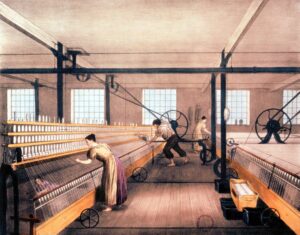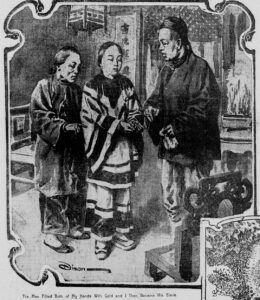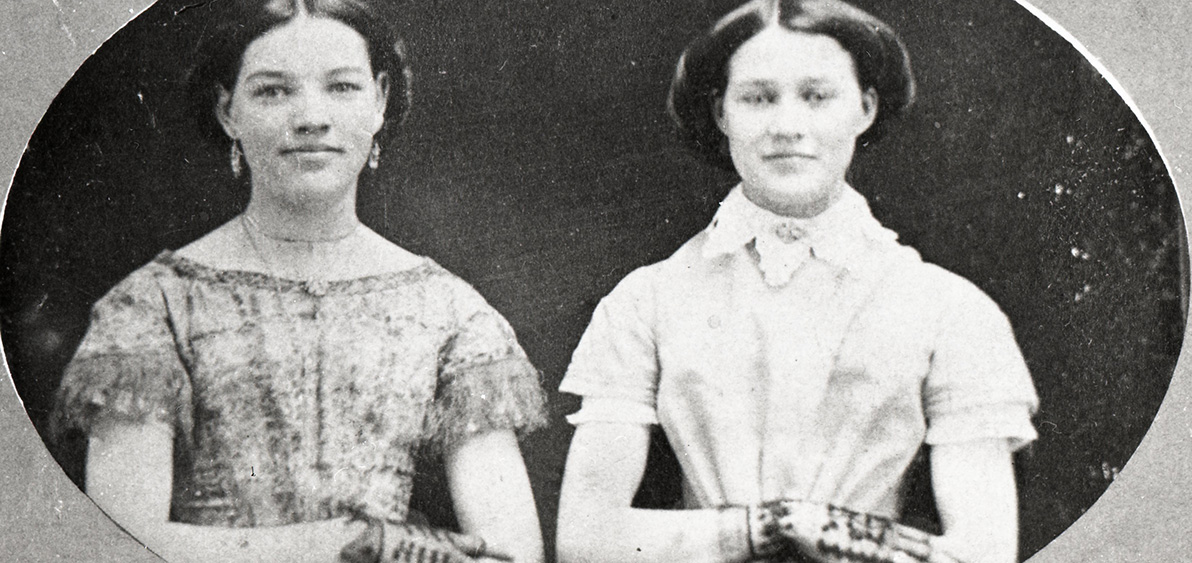Key Ideas
- The mid-19th century was a transformative time in American history.
- The role and expectations of women evolved rapidly in the mid-19th century.
- The experiences of women in this period varied widely based on race, class, age, gender identity, and geographic region.
Introduction

Spinning cotton with self-acting mules of type devised by Richard Roberts (1825). Print c1835. World History Archive / Alamy Photo
In most histories of the United States, the mid-19th century is dominated by the narrative of the Civil War. But beyond the war, this period was one of rapid and monumental transition. In these decades, the U.S. expanded swiftly and undertook an organized campaign to divest Indigenous people of their lands and sovereignty. The Industrial Revolution transformed work, home, and the way people lived their lives. The exponential increase in immigration to the U.S. created new questions about American identity and culture. The questions surrounding slavery and the status of free Black Americans tore the country apart. And each of these developments had profound effects on the political and social landscape of the country.
These decades also proved to be a critical period in the history of American womanhood. Expansion and industrialization offered women new opportunities to assert their independence. Some women began to wonder whether it was possible for women to achieve social and political equality with men. But there were many obstacles to overcome, starting with defining what such a future might look like and who should benefit from it. From its earliest days, the emerging women’s movement struggled to answer and build consensus around such questions. And, of course, not all people agreed gender equality was the goal. Conservative reformers, for example, advocated for women to play a complementary but fundamentally separate role from men in U.S. society.
Expansions and Inequalities, 1830–1869, provides resources to allow you to explore the complicated and fascinating history of this period. The unit contains three sections: Westward Expansion, Industry and Immigration, and Politics and Society. The questions surrounding slavery and freedom as well as the events of the Civil War and Reconstruction appear throughout, but you’ll find a more thorough examination of all these topics in A Nation Divided: 1832–1877. Each section contains resources that illustrate the experiences of a wide range of women across race, gender, age, social, and economic spectrums. You’ll meet women who pushed boundaries, and women who operated within them. Some of these stories will inspire, and some will provoke important discussions about justice and personhood. Many resources can easily be incorporated into your lessons, allowing you to seamlessly include women in your history curriculum. And some may inspire new lessons on topics that will enrich your students’ understanding of their nation’s history. Many of the resources “speak” to each other in interesting ways, allowing you and your students to compare and contrast women’s experiences across geographical, political, and social lines.

The San Francisco call. [volume], April 02, 1899, Image 25. Chronicling America: Historic American Newspapers. Library of Congress.
To get started, you can explore the 50 resources that make up this unit in two different ways: by “section” or by “theme.” Each resource comes with background information, a vocabulary list, and suggested activities for how you might integrate it into your lessons. There are also links included on each resource page that will connect to other resources by topic or theme, so you can continue to follow interesting threads and see where they take you.
Unit Essential Questions
- What role did women play in the transformation of the U.S. in the mid-19th century?
- Why is it important to consider women’s narratives and perspectives when learning about westward expansion, industrialization, and immigration?
- How did women’s experiences vary because of race, class, age, gender identity, and geographic region?
Explore by Section
To learn about the mid-nineteenth century by topic, explore the three sections below!
Westward Expansion
Between 1830 and 1869, thousands of settlers poured into the lands west of the Mississippi River. This mass migration had profound effects on the lives of women of all races and social classes.
Go NowIndustry and Immigration
The inventions and innovations of the Industrial Revolution transformed every aspect of American life, from the food people ate to the games they played. Meanwhile, thousands of new arrivals brought with them new traditions and cultural practices that still influences American society today.
Go NowPolitics and Society
The mid-1800s were characterized by great social, cultural, and political upheavals that resulted in the formation of a new movement to obtain equal citizenship for American women.
Go NowFor more on the American Civil War and Reconstruction, please visit A Nation Divided: 1832–1877.
Explore by Theme
Explore resources related to common curricular topics and themes.
View All Resources
Discover all the resources in this unit below and click through to the sections to find even more background information.







